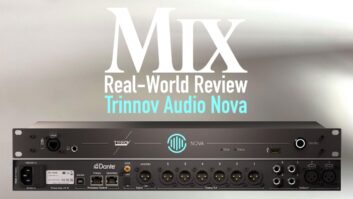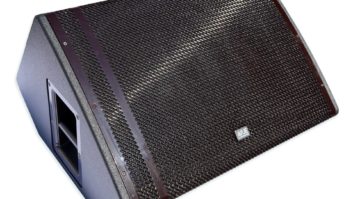
Universal Audio Apollo
The amount of outboard gear in a typical studio has dropped precipitously in this era of DAW-based recording, but there’s one piece of hardware that can’t be replaced in the box: the audio interface. Quality interfaces give you more than connectivity with your DAW and A/D and D/A conversion; they often have capable mic pre’s, line and hi-Z inputs, plentiful outputs, mixing and routing software, low-latency hardware monitoring, internal mixers for routing—often controlled by software that you can edit from your computer—and some degree of built-in DSP.
Based on the features, build-quality, and component quality, interfaces truly run the gamut price-wise. You can spend under $100 for a no-frills USB 1.1 model with one or two inexpensive mic pre’s, or close to $6,000 for a top-of-the-line, pro audio quality FireWire 800 unit with pristine converters, high-end pre’s, and numerous and varied I/O options.
In the audio interface field, like in other areas, advances in technology are sparking design changes, and this is impacting the products being released. The goal here is to spotlight some of the intriguing new audio interfaces that have hit the market, to see how they fit in those trends, and to try to discern where the market is headed in terms of product design, connectivity standards and more.
Dual Role
One of the most talked about recording products at this year’s NAMM show was the Universal Audio Apollo. More than just a high-quality interface, Apollo also has the equivalent of a UAD-2 Duo or Quad card built in, depending whether you buy the Apollo Duo ($1,999) or Apollo Quad ($2,499) model.
As mentioned, DSP is relatively common in audio interfaces. MOTU, RME, Metric Halo, Steinberg, Focusrite and PreSonus are among the manufacturers who have interfaces that include onboard processing of some sort, but the Apollo takes the concept into new territory by combining the power and flexibility of its hardware accelerator cards with the functionality and features of an interface. Both Apollo models come loaded with the Classic Analog Processors Bundle, which comprises five UAD-2 plug-ins, including several classic plug-in emulations, a reverb and a channel strip. You have to purchase the others separately, but you have Universal Audio’s entire plug-in lineup to choose from (you do get a $100 voucher toward your first plug-in purchase). You can track or monitor through these effects, and also access them from your DAW during mixdown, just like you would with a standard UAD-2 card. Because the processing happens within Apollo, using its effects will have no impact on your resident CPU and offers low latency, down to a promised 2 ms, which is short enough not to be a distraction to musicians or singers who are recording.
The interface portion of this single-rackspace unit offers 18 inputs and 24 outputs, including analog and various forms of digital I/O, and can handle up to 24-bit, 192kHz audio. On its rear panel are four high-quality mic pre’s. Unlike UA’s outboard pre’s, such as the 2-610 or 4-710d, the pre’s on the Apollo are not made to impart a “sound.”

MOTU’s bus-powered MicroBook II offers hands-on volume control, USB 2 connectivity for low-latency performance, more simultaneous outputs (six), an XLR mic input, and support for 96kHz recording and playback.
“It is meant to be pristine, with no coloration,” says UA Product Manager Lev Perry, referring to type of mic preamp used in the Apollo. “All coloration, if desired, can be accessed through our suite of UAD Powered Plug-Ins, in real time.”
Bolts of Thunder
Connectivity is another area in which Apollo is breaking new ground. Although it comes standard with a FireWire 800 port, it also includes a slot for an optional Thunderbolt I/O card, which will be available sometime this summer. Thunderbolt, the connectivity standard being co-developed by Intel and Apple, is on all recent Mac models and will soon be available in Windows machines, as well.
“Thunderbolt is clearly going to be a big deal,” says Jim Cooper of MOTU, a company that’s been in the audio interface business for a long time, and which just put out its first Thunderbolt-equipped product, the HDX-SDI video interface. “Thunderbolt’s got a lot of really nice benefits, starting with the plug-and-play convenience of FireWire,” Cooper says. “You can hot swap and daisy-chain with it, and you also combine the convenience of FireWire with the latency performance of PCI Express—plus about 8 times its bandwidth.”
Thunderbolt incorporates PCI-Express technology (which currently offers higher bandwidth than FireWire or USB), but it gives you even faster data-transfer speeds. According to Apple, it’s 20 times faster than USB 2, 12 times faster than FireWire 800, eight times faster than PCI-Express, and twice as fast as USB 3. Most audio interface manufacturers are working on developing implementation of it for their products. For example, Apogee has announced the Symphony 64 | ThunderBridge, a Thunderbolt card for its Symphony I/O interface. The company has not specified a release date, as of yet.

The Lynx Hilo is a 2-channel AD/DA converter with touchscreen interface, separate monitor/headphone outs, multiple digital options, an expansion port for future protocols, high-speed USB 2 interface, and onboard 32×32 mixer.
Phil Moon of Lynx Studio Technology predicts that Thunderbolt implementation will be included in a lot of products shipping later this year. “I would imagine that at this year’s AES show, you’ll likely see a lot of Thunderbolt products, probably pretty close to shipping, and probably early in the year, we’ll have a lot.”
Back in December, Prism Sound announced Thunderbolt connectivity with its Orpheus and ADA-8XR interfaces, using Sonnet’s Echo ExpressCard/34 Thunderbolt Adapter ($150). Users of those Prism interfaces (and theoretically, any Express/Card-equipped interface) can now access their Macs through the Thunderbolt port. Using an adapter doesn’t provide the speed of a native Thunderbolt connection, but it does allow you to use your ExpressCard interface through a Thunderbolt port.

M-Audio ProFire 2626 High-Definition 26-in/26-out FireWire Audio Interface with Octane Preamp Technology
For the near term, Thunderbolt will probably only be used on interfaces in the higher end of the market because its chipset is expensive. But as economies of scale take over, the price is likely to drop.
The elephant in the room in the format discussion, and potentially the ultimate connectivity format, is AVB (Audio Video Bridging). All of the manufacturers we spoke to seemed extremely enthusiastic about its potential. It’s based on a spec from IEEE that will allow the transmission of large data streams through Ethernet cables. In addition to high-bandwidth data transfers and low latency, AVB enables long cable runs and the ability to network devices. The AVB spec isn’t totally finished yet, but enough of it has been completed to allow manufacturers to start building it into their audio devices. According to industry sources, AVB-enabled audio products are likely to start shipping sometime this year. Focusrite hopes to start shipping RedNet, which provides studio networking over Ethernet, later this year. RedNet uses Audinate’s Dante technology, but is AVB compliant.

Metric Halo Mobile I/O ULN2 Expanded
AVB and Thunderbolt may be the sleek, fast and glamorous new kids on the block, but for personal studio interfaces, where you don’t need to record high-resolution multitrack audio, good old reliable USB 2 can hold its own quite nicely. What’s more, it doesn’t appear that the USB format is going away anytime soon. USB 3 is only months from hitting the market, and has some very impressive specs. However, its future in the interface world isn’t clear yet. One thing that will make USB 2 interface owners happy: USB 3 is backward-compatible, so with only an inexpensive adapter cable, you’ll be able to use USB 2 devices in USB 3 ports.
How all this format upheaval will shake out is hard to predict. Based on the potential of the other formats, it’s a pretty good bet that FireWire is going to be supplanted as the professional connectivity choice for DAW users.

Steinberg UR-824
Movable Hardware
Another apparent pattern in the interface market of late is the popularity of desktop units over rackmount ones. Of the new units we surveyed for this story, there were only two with rackmount form factors: the Apollo and Steinberg’s new UR-824 ($799), which is an intriguing 24×24 interface with discrete Class-A preamps, built-in DSP including channel strips and reverb, USB 2 connectivity and more.
The preponderance of recently released interfaces are of the desktop, not the rackmount variety, and “that does seem to be a trend,” says Steve Oppenheimer, public relations manager for PreSonus, one of the leading audio interface manufacturers, “the fact that you can throw your interface into a laptop bag and go.”

RME Fireface UCX
Several desktop interfaces have emerged in the higher end of the market. One of the most impressive is RME’s Fireface UCX ($1,649 street), which started shipping in January of this year. It offers excellent quality, lots of I/O options and generous built-in DSP. Among its features are low-latency converters, two mic pre’s, USB 2 and FireWire 400 ports, and 18×18 I/0 at 48 kHz (12×12 at 192 kHz) including 8 analog ins and outs. Two onboard digital signal processors, used in conjunction with RME’s TotalMix FX software, provide access to reverbs, delays, EQs and compressors that can be applied on input or for monitoring only. An optional remote control can also be purchased.
Metric Halo has years of experience producing portable interfaces, and in the fall it started shipping its Mobile I/O ULN 2-Expanded ($1,695) interface, which includes a pair of the company’s Ultra Low Noise mic preamps; extremely low latency converters; and AES/EBU, S/PDIF and ADAT/TOSLINK digital I/O. You also get an onboard software mixer and DSP chip, which, when you add the optional DSP+ software, gives you onboard reverb, EQ and compression. And, because it’s designed to be used in the field as well as the studio, it has a 4-pin XLR port that lets it run on standard broadcast batteries.
The Lynx Hilo ($2,495) has no mic pre’s and is first and foremost an ultra high-quality converter box. According to Lynx, it has the best converters that the company makes, but it also includes a USB 2 card, so it can function as an interface. The Hilo offers some pretty interesting routing and I/O options. There are two analog line ins and outs on XLR jacks, balanced monitor outputs and a headphone out that’s being fed by a premium headphone amplifier. For digital I/0, it’s got AES/EBU, S/DPIF coaxial, S/PDIF optical, and 8 channels of ADAT output. All of these ins and outs are controlled by an internal mixer that’s accessed through the unit’s touchscreen interface, which makes it super easy to route any input to any output. Like the Metric Halo ULN-2, it has a 4-pin XLR that will accommodate broadcast batteries.
Almost in Your Pocket
As the previous few products show, there is plenty going on in the upper end of the market in terms of portable interfaces, but there’s even more action in the middle and lower end, where features and sound quality are improving, while prices drop.
One example is the USB 2–based MOTU Microbook II ($249), which is due to start shipping this spring. Housed in a 5.5×3.5-inch, 1.25-pound metal body, the pint-sized interface has two big, multifunction rotary encoders on the top, and one XLR mic input, one hi-Z guitar input and two ¼-inch line inputs. On the output side, you get a pair of analog outputs on balanced ¼-inch jacks, a 1/8-inch stereo line out, an S/PDIF output on an RCA jack and a stereo ¼-inch headphone out. According to MOTU, the mic pre and overall audio quality is similar to what’s in the company’s 828 and 896 interfaces. Also included is MOTU’s CueMix FX software, which lets you set up latency free hardware monitor mixes and access built-in EQ and compression. The Microbook II is bus-powered, but doesn’t have a MIDI port.

Akai Professional EIE Pro
Focusrite’s Scarlett range offers three USB 2 models, each with different I/O counts: the 18i6 ($299), 8i6 ($249), and 2i2 ($199). The first number in each name designates the input count and the second the number of outputs. All three come with a pair of Focusrite mic pre’s, which, according to the company, are the same as the ones used in its Saffire line, although the Scarlett’s internal circuitry and chip sets are different. The two largest models are just over 8.5 inches wide, while the 2i2 is 5 inches wide, so they’re extremely portable. In addition to having MIDI ports, the 18i6 and the 8i6 come with Focusrite’s MixControl software, which lets you create low-latency monitor mixes. The 2i2 has no MIDI port or control software, but it’s the only one of the three that’s bus-powered, and it weighs in at a svelte 1.3 pounds.
Other new portable interfaces include the Akai Professional EIE Pro, a 4×4 interface with a MIDI port and a three-port USB hub built in; and the Roland Tri-Capture and Duo-Capture, which are smaller siblings of the previously released, and larger, Octa-Capture.
Take One Tablet
Apple’s iPads have good audio capabilities, and numerous music apps have been developed for them. We’re now starting to see more iOS integration in the audio-interface category, too, with products slowly starting to appear. Based on the popularity of iOS devices in other areas of audio production, it stands to reason that plenty more will be on the way.

Alesis iOMix
Alesis, which earlier released the iO Dock interface ($199), announced another iOS unit at Musikmesse: the iOMix (pricing TBA). Scheduled to be released later this year, the iOMix functions as a 4-channel mixer with physical knobs, and as an interface. It offers four XLR/¼-inch combo input jacks, phantom power, balanced ¼-inch outs, and even a video output to send the iPad’s video to projectors and TVs.
Meanwhile, the Tascam IU2 ($149), an interface compatible with the iPad, iPhone and iPod touch, as well as Mac and Windows computers, is expected to be shipping by the time you read this. It has two XLR mic pre’s with phantom power, a pair of balanced line inputs, an instrument level input, and an S/PDIF output, and it offers zero-latency monitoring.
On the higher end, the previously mentioned RME Fireface UCX has a Class Compliant Mode, which allows it to work with an iPad when connected via Apple’s Camera Connection Kit. Any USB device that’s class-compliant can function in this way, so other interfaces may be compatible.
In addition, iOS apps that control studio hardware wirelessly are becoming more and more common. For example, PreSonus has apps that control its StudioLive digital mixers (which are also audio interfaces). It stands to reason that there will be app-based control of audio interfaces in the future.
Digital Out
Like all product categories that rely on digital technology, the interface market is always in a state of flux, to some degree. Where it will go in the next few years depends on what happens in the computer market. It appears that Apple may be plotting a course that could eventually combine the laptop and the tablet, and make the desktop computer obsolete. If that occurs, what would it mean for music production software?
And then there’s the connectivity issue. Will Thunderbolt dominate the market or might AVB become the pro format of choice? Maybe both will be important.
Nobody knows how it’s all going to shake out, but it’s certainly likely that the audio interface of two years from now will be more powerful, more feature-laden and of higher-quality. That can’t be a bad thing.
Mike Levine is a musician, producer, and music journalist from the New York area.






